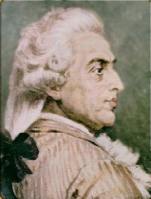Stanislaus II Augustus Poniatowski, King of Poland
|
|
For other persons named "Stanisław Poniatowski," see Stanisław Poniatowski.
| Stanisław August Poniatowski | |
|
| |
| Reign | September 7, 1764, to November 25, 1795. |
| Elected | September 7, 1764, at Wola, now a district of Warsaw, Poland. |
| Coronation | November 25, 1764, in St. John's Cathedral, Warsaw, Poland. |
| Noble Family | Poniatowski. |
| Coat of Arms | Ciołek. |
| Parents | Stanisław Poniatowski, Konstancja Czartoryska. |
| Consorts | Catherine II of Russia; Elżbieta Grabowska; et al. |
| Children | with Catherine II of Russia, Anna; with Elżbieta Grabowska, 2 daughters, 3 sons. |
| Date of Birth | January 17, 1732. |
| Place of Birth | Wołczyn, Poland. |
| Date of Death | February 12, 1798. |
| Place of Death | Saint Petersburg, Russia. |
| Place of Burial | Currently, St. John's Cathedral, Warsaw. |
Stanislaus Augustus (born Stanisław Antoni Poniatowski; January 17, 1732, Wołczyn, Poland - February 12, 1798, St. Petersburg, Russia) was the last king of the Polish-Lithuanian Commonwealth (1764-1795). He was the son of Stanislaw Poniatowski, Castellan of Kraków, and brother of Michal Jerzy Poniatowski, primate of the Roman Catholic Church in Poland.
| Contents |
Royal titles
(English translation, from the Polish text of the May 3rd, 1791, Constitution:) Stanisław August, by the grace of God and the will of the people King of Poland and Grand Duke of Lithuania, Ruthenia, Prussia, Mazowsze, Samogitia, Kyiv, Volhynia, Podole, Podlasie, Livonia, Smolensk, Siewierz and Chernihiv.
Biography
Born in 1732, Poniatowski already at twenty, in 1752, as a Sejm deputy attracted attention with his oratory. He ultimately owed his career, however, to his uncles, the powerful Czartoryskis, who in 1755 sent him to Saint Petersburg, Russia, in the suite of the British ambassador, Sir Charles Hanbury-Williams. There, through the influence of Russian Chancellor A. P. Bestuzhev-Ryumin, he gained accreditation to the Russian court as ambassador of Saxony. Through Hanbury-Williams he met twenty-six-year-old Grand Duchess Catherine, who was irresistibly attracted to the handsome and brilliant young nobleman, for whom she forsook all other lovers.
Portrait_of_King_Stanislaus_Augustus_Poniatowski_with_an_Hourglass.jpg
After returning to Warsaw, Poniatowski won election (September 7, 1764) as king of Poland through the influence of Catherine, since become Empress Catherine II of Russia. (She had promised him the crown as early as October 1763.) The coronation took place November 25, 1764. The new King's uncles in the Familia would have preferred another nephew, Prince Adam Kazimierz Czartoryski, on the throne but he had declined to seek the office.
Stanisław August--as he now styled himself--as king of a near-anarchic Polish-Lithuanian Commonwealth remained at the mercy of circumstances. Nevertheless, in his difficult situation he strove to do his duty. He inaugurated some useful economic changes. He supported the Familia's reform program until 1766, when he fell out with his uncles. He protested the first partition of Poland (1772); but being powerless to do anything about it, and in the face of implacable opposition from Polish magnates, he was obliged to place his reliance in Russia's German ambassador, Otto Magnus Stackelberg. Acting in concert, he hoped to strengthen his authority and bring about essential reforms. It was only during the Four-Year Sejm of 1788-1792 that he threw in his lot with the reformers, centered in the Patriotic Party, and with them co-authored the May 3rd Constitution of 1791.
His eloquent speech before the Sejm on taking an oath to uphold the newly adopted Constitution--the world's second written national constitution, and Europe's first--moved his audience to tears. But when the Targowica Confederation, with the connivance of Russia's Catherine the Great, was formed to overthrow the Constitution, the King upon her demand and the recommendation of some advisers, including the otherwise usually radical Hugo Kollataj, acceded to the Confederation. This undermined the operations of the Polish Army, which under Tadeusz Kosciuszko and the King's own nephew, Prince Jozef Poniatowski, had been performing prodigies on the battlefield.
King Stanisław August remains a controversial figure. He was accused by some of striving for absolutism, of doing away with the liberties of the szlachta (Polish nobility), of desiring the downfall of the Roman Catholic Church; by others, of weakness and subservience, even of treason, especially after he had joined the Targowica Confederation.
Nevertheless, he did accomplish much in the realm of culture and education. He founded the School of Chivalry (otherwise "Corps of Cadets"), which functioned 1765-1794 and whose alumni included Tadeusz Kościuszko; and the Commission of National Education (1773), the world's first national ministry of education. In 1765 he helped found the Monitor, the leading periodical of the Polish Enlightenment, and the Polish national theater. He hosted his famous "Thursday dinners," the most brilliant social functions in the Polish capital. He supported the establishment of manufactures and the development of mining. He remodeled Warsaw's Royal Castle, and erected the elegant Royal Baths Palace (Pałac łazienkowski) complex in Warsaw's most romantic park. He created a numismatic collection, a picture gallery, and an engravings room.
After the final, Third Partition of Poland, Stanisław August was forced to abdicate (November 25, 1795) and left for St. Petersburg, Russia. There, a virtual prisoner, he subsisted on a pension from Catherine the Great and died deeply in debt. In 1938 his remains were transferred to a church at Wołczyn, his birthplace, and in 1995 to St. John's Cathedral in Warsaw, where on May 3, 1791, he had celebrated the adoption, earlier that day, of the Constitution that he co-authored.
| Preceded by: Augustus III | King of Poland 1764-1795 | Succeeded by: — Template:End box Template:Kings and Dukes of Poland See also
References
|

